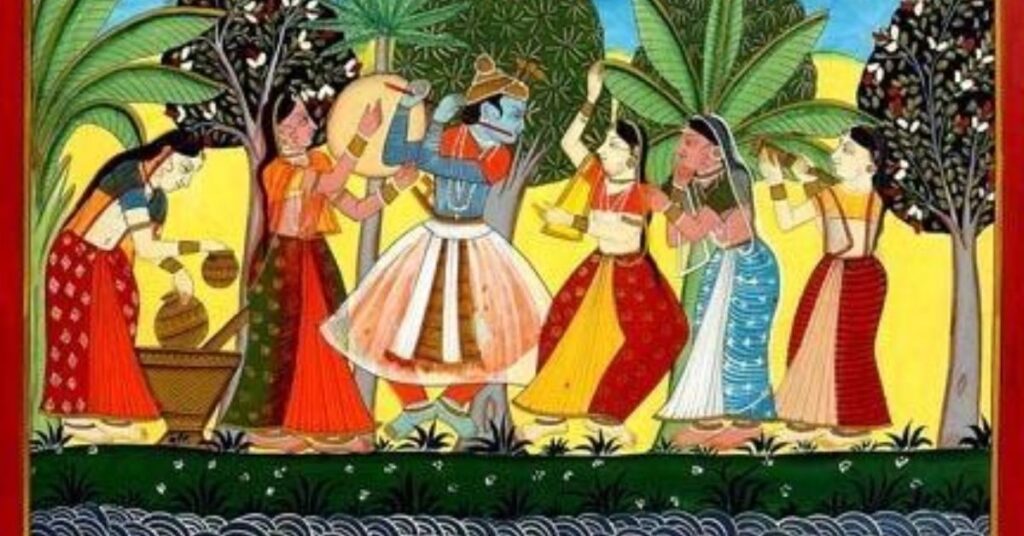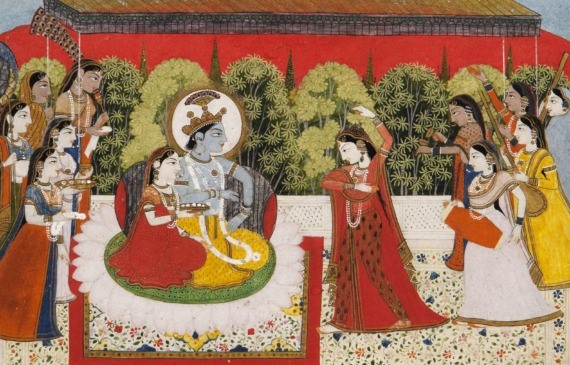The Pahari School of Painting, flourishing between the 17th and 19th centuries in the hilly regions of western Himalayas, represents India’s rich heritage. Over time, it evolved from the vivid Basholi style into the more refined Kangra tradition. Pahari paintings covered a wide range of themes, capturing mythology, literature, and everyday life in the hills. The importance of Pahari paintings lies in their ability to offer a glimpse into the historical and cultural history of the region they originated from. In this article, you will know about meaning of Pahari School of Painting, key features of Pahari School its various traditions including Basholi and Kangra, which is important for GS Paper-1 Art & Culture of UPSC IAS Exam. To explore more interesting UPSC Art & Culture Class 12 topics like Deccani Schools of Painting, check out other articles and IAS Notes of IASToppers.
Table of Content
- Pahari School of Painting (17th-19th century)
- Key features of Pahari School of Painting
- Basholi Tradition (from 17th century)
- Kangra Tradition (from mid-18th century)
- Other Schools of Pahari Paintings
- Conclusion
Pahari School of Painting (17th-19th century)
- The term ‘Pahari’ has its roots in ‘hilly or mountainous’.
- The Pahari Schools of Painting refer to the artwork originating from various mountain towns, such as Basohli, Guler, Kangra, Kullu, Chamba, Mankot, Nurpur, Mandi, Bilaspur, Jammu, and more, located in the western Himalayas.
- These towns flourished as hubs of painting between the 17th -19th centuries under the influence of the Mughal style.
- Numerous schools thrived in the smaller Rajput kingdoms, all of which fell under the category of ‘Pahari Art’.
- These schools had ateliers in the courts of 22 royal states extending from Jammu to Almora.
- The Pahari style of painting started with a vivid style in Basohli and gradually evolved into a more refined form, known as the Kangra School, through the Guler or pre-Kangra phase.
Key features of Pahari School of Painting
- Pahari School of Painting covered a wide range of themes, from mythology to literature, and introduced innovative techniques.
- A typical Pahari painting would incorporate several characters, all filled with movement.
- Each character is unique in design, color, and pigment.
- Nainsukh, Manaku, and Sansar Chand were among the most notable artists of this tradition.
- Nainsukh was a court painter for the rulers of Jammu and Kashmir. He is known for his portraits of Radha and Krishna, as well as his depictions of everyday life in the hills.
- Manaku was a brother of Nainsukh. He is known for his delicate and lyrical paintings of Krishna and Radha.
- Sansar Chand, a ruler of Kangra, commissioned many paintings, including some of the most famous Kangra paintings.
Basholi Tradition (from 17th century)
- Basholi School of Painting is a style of miniature painting of pahari school that developed in the 17th century in the Basholi region of Jammu and Kashmir, India.
- This early phase had expressive faces with a receding hairline and lotus petal-shaped large eyes.
- These artworks made significant use of primary colors such as red, yellow, and green.
- They employed the Mughal method of painting on fabric but evolved their own styles and techniques over time.
- This tradition is known for its use of contrasting colors, which were inspired by the Malwa paintings.
- One of the standout features is the use of tiny, bright green beetle wing fragments to depict jewellery and imitate the shine of emeralds.
- These paintings share similarities with the Chaurpanchashika group of paintings from Western India in their lively colour scheme and grace.
- The Rasamanjari of Bhanu Datta was a favourite subject of Basohli painters. Bhagvata Purana and Ragamala were other popular themes.
- Artists also painted portraits of local kings with their consorts, courtiers, astrologers, mendicants, courtesans and others.
- Some of the most famous Basholi painters include Raja Kirpal Pal and Devi Das.
- Raja Kirpal Pal was the first patron of this tradition, commissioning illustrations of Bhanudatta’s Rasamanjari, Gita Govinda, and drawings from the Ramayana.
- Devi Das, the most renowned artist from this tradition, was well-known for his portrayals of Radha Krishna and depictions of kings in their royal attire and white clothing.
Kangra Tradition (from mid-18th century)
Alt-text: Kangra Tradition of Pahari School
- Following the downfall of the Mughal empire, a number of artists versed in the Mughal style relocated to the Kangra area of Himachal Pradesh, attracted by the patronage of the Rajput Kingdom. This migration led to the emergence of the Guler-Kangra Painting Tradition.
- Initially developing in Guler, it later transitioned to Kangra.
- This tradition achieved its peak under the patronage of Raja Sansar Chand, whose paintings were characterized by a level of sensuality and intellect that set them apart from other schools.
- The Kangra style is by far the most poetic and lyrical of Indian styles.
- The most distinctive feature of this style is delineation of the female face, with straight nose in line with the forehead.
- Common subjects depicted included the Gita Govinda, Bhagwata Purana, Biharilal’s Satsai, and Nal Damayanti.
- Romantic scenes involving Krishna with gopis were a dominant theme.
- Another prominent series of paintings is the ‘Twelve Months’, where the artist attempted to illustrate the impact of each of the twelve months on human emotions. This emotive style remained popular until the 19th century.
- The Kangra tradition gave rise to other workshops that evolved in the regions of Kullu, Chamba, and Mandi.
- Painting activity was severely affected around 1805 when the Gurkhas besieged the Kangra fort and Sansar Chand had to flee to his hill palace at Tira Sujanpur. In 1809, with the help of Ranjit Singh, the Gurkhas were driven away.
Other Schools of Pahari Paintings
Chamba Style
- It derived its name from a princess Champavati, a daughter of Raja Sahila and a tree with fragrant golden flowers champaka or chamba as it is known in the hills.
- It exhibit characteristics similar to Mughal art and had influence from Deccan and Gujarat painting styles.
- Late 17th century saw the Chamba style being overtaken by the Basohli style, which eventually led to the development of Guler painting tradition.
Bilaspur Style
- The town of Bilaspur in Himachal Pradesh saw the rise of Pahari paintings around the mid-17th century.
- Paintings depict Bhagavata Purana, Ramayana, Ragamala sequence, as well as coverlets for ceremonies and rites.
- Silver and gold were used. Beetle wings represent jewellery.
Guler-Kangra Style
- The Guler Kangra style emerged around the year 1800.
- This style was a more naturalistic adaptation of painting, showing distinct differences in the depiction of eyes and facial structure.
- Landscapes were commonly used as themes, and there was a focus on portraying the elegance and sophistication of Indian women.
Garhwal Style
- Garhwal style originated in Srinagar as painters from other regions migrated there.
- Initially, it was heavily influenced by the Mughal style.
- Over time, it began to incorporate a simpler version of Kangra traditions.
Kulu Style
- Kulu style includes two Madhu-malati manuscripts, Bhagavata Purana, and more.
Mandi Style
- Mandi saw the emergence of a unique painting style during the reign of Raja Sidh Sen (1684 to 1727).
- The paintings often depicted the ruler as a huge figure with oversized heads, hands, and feet.
- Other artworks were characterized by geometric patterns and subtle realistic details.
Nurpur Style
- Nurpur paintings are found in Himachal Pradesh.
- They are known for their vibrant colours and plain backgrounds.
- In later stages, the vibrant hues were replaced by more muted tones.
Jasrota Style
- Jasrota paintings are primarily found in Jammu and Kashmir.
- They revolve around the lives of the kings, court scenes, symbolic representations, and more.
Mankot Style
- Mankot paintings can be found in Jammu and Kashmir.
- They show a resemblance to the Basohli style.
- The style uses bright colours and bold themes.
- By the mid-17th century, portraiture became a common theme.
- Over time, the focus shifted towards naturalism and softer colours.
Conclusion
Pahari School of Painting, which flourished from the 17th to 19th centuries, is a remarkable testament to India’s rich artistic heritage. Encompassing a variety of styles from Basohli to Kangra, these art forms reflect the diverse cultural nuances of the region. Their inherent beauty and the stories they tell continue to captivate, offering invaluable insights into India’s historic and cultural uniqueness.
Ref: Source-1
FAQs (Frequently Asked Questions)
What is Pahari School of Painting?
Pahari School of Painting refers to the artwork originating from various mountain towns in the western Himalayas between the 17th and 19th centuries.
What are the key characteristics of pahari school of miniature painting?
The key features of pahari school of miniature painting are vivid depictions, unique designs and colors for each character, and a wide range of themes from mythology to literature
What are the main themes of pahari painting?
Pahari paintings depict a variety of themes such as mythology, literature, everyday life in the hills, and romantic scenes involving Krishna.
What are some of the famous pahari miniature paintings?
Some of the famous pahari miniature paintings include portraits of Radha and Krishna by Nainsukh, delicate paintings of Krishna and Radha by Manaku, and the commissioned works of Raja Sansar Chand of Kangra





